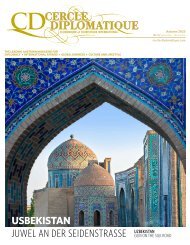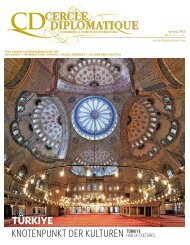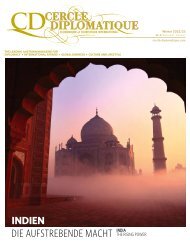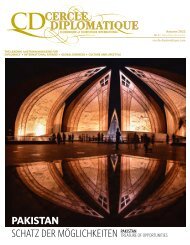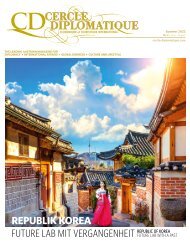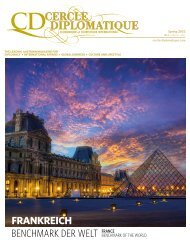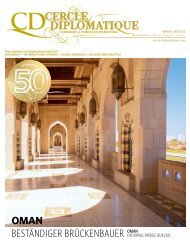CERCLE DIPLOMATIQUE - issue 02/2023
CD is an independent and impartial magazine and is the medium of communication between foreign representatives of international and UN-organisations based in Vienna and the Austrian political classes, business, culture and tourism. CD features up-to-date information about and for the diplomatic corps, international organisations, society, politics, business, tourism, fashion and culture. Furthermore CD introduces the new ambassadors in Austria and informs about designations, awards and top-events. Interviews with leading personalities, country reports from all over the world and the presentation of Austria as a host country complement the wide range oft he magazine.
CD is an independent and impartial magazine and is the medium of communication between foreign representatives of international and UN-organisations based in Vienna and the Austrian political classes, business, culture and tourism. CD features up-to-date information about and for the diplomatic corps, international organisations, society, politics, business, tourism, fashion and culture. Furthermore CD introduces the new ambassadors in Austria and informs about designations, awards and top-events. Interviews with leading personalities, country reports from all over the world and the presentation of Austria as a host country complement the wide range oft he magazine.
Create successful ePaper yourself
Turn your PDF publications into a flip-book with our unique Google optimized e-Paper software.
SAVOIR VIVRE WATER AS CULTURAL HERITAGE<br />
Walter Kling Präsident IAWD, stv. Leiter Wiener Wasser i. R. | President of<br />
the IAWD, deputy head of Vienna Water (retired)<br />
„Immense Handlungsnotwendigkeit.“ “Immense need for action.”<br />
Über 150 Jahre<br />
Wiener Hochquellwasser:<br />
Wie voraussehend<br />
die damalige<br />
Entscheidung im<br />
Wiener Gemeinderat<br />
war, aus Quellen der<br />
Voralpen über eine<br />
lange Distanz eine Leitung zu bauen, führt uns<br />
das Jubiläumsjahr nochmals vor Augen. Das<br />
Wiener Hochquellwassser ist einzigartig. Zur<br />
Bewältigung der heutigen Herausforderungen<br />
– und damit meine ich den Klimawandel – ist es<br />
absolut notwendig, ebenso wie damals, richtige<br />
und nachhaltige Entscheidungen für die<br />
nächsten 150 Jahre zu treffen!<br />
Zur Wiener Wasserversorgung im Kontext<br />
der Klimakrise:<br />
Wien ist in der privilegierten Lage, dass die<br />
Stadt von der Auswirkung des Klimawechsels<br />
nicht am härtesten getroffen wird. Wir haben<br />
unsere Quellen und die Voralpen in der Nähe,<br />
das Wasserangebot für die Stadt Wien ist also<br />
noch immer reichlich vorhanden. Dies entledigt<br />
uns aber bei weitem nicht der Verantwortung,<br />
die notwendigen Vorkehrungen zu treffen. Wir<br />
haben einfach ein bisschen mehr Reaktionszeit<br />
als viele prekäre Gegenden der Welt. Mit der<br />
Strategie „Wiener Wasser 2050“ haben die<br />
Wiener Wasserwerke Überlegungen, Studien<br />
und Wissen verfügbar gemacht, um auch der<br />
Politik eine Grundlage zu geben, die richtigen<br />
Entscheidungen zu treffen.<br />
Zum Auftritt der IAWD bei der UN Water<br />
Conference:<br />
Das „Danube Water Programm“ der IAWD,<br />
wo wir seit 10 Jahren gemeinsam mit der<br />
Weltbank den Wissensaustausch im Donauraum<br />
institutionalisiert haben, wurde auf der UN<br />
Wasser Konferenz als Best-Practice Beispiel<br />
präsentiert. Weltweit wurden 1.300 Initiativen<br />
bei der Konferenz eingereicht, knapp über 200<br />
konnten überhaupt gehört werden. Global<br />
gesehen ist Wasser ein Thema, das unter<br />
riesigem Druck für Lösungsmöglichkeiten steht.<br />
Die Handlungsnotwendigkeit ist immens.<br />
96 Cercle Diplomatique 2/2<strong>02</strong>3<br />
Over 150 years of Vienna mountain spring<br />
water:<br />
The anniversary year reminds us once again of<br />
how visionary the decision of the Vienna City<br />
Council was to build a pipeline from the sources in<br />
the foothills of the Alps over a long distance.<br />
Vienna’s mountain spring water is unique. To tackle<br />
today’s challenges, and by that, I mean climate<br />
change, it is absolutely necessary to make the right<br />
and sustainable decisions for the next 150 years,<br />
just as we did back then!<br />
On Vienna’s water supply within the context<br />
of climate change:<br />
Vienna is fortunate to be less severely impacted by<br />
the consequences of climate change. With our<br />
proximity to water sources and the nearby foothills<br />
of the Alps, the water supply in Vienna remains<br />
plentiful. However, this does not absolve us of our<br />
responsibility to take necessary precautions. We<br />
have the advantage of having a bit more time to<br />
respond compared to many vulnerable regions<br />
around the world. The “Vienna Water 2050”<br />
strategy, developed by the Vienna Waterworks<br />
provides valuable considerations, studies, and<br />
knowledge to guide policymakers in making<br />
informed decisions.<br />
On the IAWD’s participation in the UN Water<br />
Conference:<br />
The IAWD’s “Danube Water Program”, which we<br />
have jointly created with the World Bank over the<br />
past 10 years to facilitate knowledge exchange in<br />
the Danube region, was showcased as a prime<br />
example of best practices at the UN Water<br />
Conference. Among the thousands of initiatives<br />
submitted worldwide, only a select few, including<br />
ours, had the opportunity to be presented. Water is<br />
a pressing global <strong>issue</strong> that demands urgent<br />
solutions. The need for action is immense.<br />
Der Hochstrahlbrunnen.<br />
Eröffnung durch Kaiser<br />
Franz Joseph 1873<br />
(unten).<br />
The Hochstrahlbrunnen<br />
fountain, opened by<br />
Emperor Franz Joseph in<br />
1873 (below).<br />
water without the need for a single pump, relying solely<br />
on the natural gradient. Over the course of approximately<br />
24 hours, the water travels from the foothills of<br />
the Alps through numerous tunnels and over 30 aqueducts,<br />
all of which are now protected monuments, until<br />
it reaches the reservoir at Rosenhügel. From there, it is<br />
distributed to households throughout the city. In a visionary<br />
move, the Vienna City Council, amidst heated<br />
debates, decided against the technically and financially<br />
less demanding option of treating water from the Danube,<br />
and instead chose to search for clean spring water<br />
in the Alpine region. This forward-thinking decision<br />
made the city of Vienna the owner of its water sources<br />
and also established extensive water protection zones in<br />
the Alps, which have now expanded to cover an area of<br />
675 km2. On 24 October 1873, the visionary project of<br />
the First Vienna Mountain Spring Pipeline was officially<br />
inaugurated by Emperor Franz Joseph with the<br />
ceremonial opening of the Hochstrahlbrunnen fountain<br />
at Schwarzenbergplatz. In the following decades,<br />
Vienna’s population rapidly grew to over two million<br />
inhabitants. To meet the increased water demand, the<br />
Second Vienna Mountain Spring Pipeline, with its<br />
spring intakes in the Hochschwab area, was added to<br />
the city’s water supply in 1910. To this day, the two highaltitude<br />
water pipelines deliver approximately 420 million<br />
litres of fresh spring water to the city daily.<br />
Valuable resource<br />
Initially, the clean water from the pipeline was<br />
primarily seen as a crucial means of liberating Vienna<br />
from the threat of diseases like cholera. However, the<br />
positive impact of being supplied with fresh spring<br />
water extended far beyond that, as it continues to<br />
contribute significantly to the city’s unique way of life<br />
PHOTOS: WIEN TOURISMUS / LISA EDI; WIENER WASSER; WIEN MUSEUM / GRAFIK: FRANZ KOLLARZ<br />
LYCÉE FRANÇAIS DE VIENNE<br />
F r e n c h & I n t e r n a t i o n a l<br />
A GLOBAL & UNIQUE NETWORK<br />
THE AEFE,<br />
552 schools in 138 countries<br />
PLURILINGUISM<br />
& CULTURAL DIVERSITY<br />
5 taught languages & more than<br />
80 nationalities<br />
A GRADUATION WITH MIT 2 DIPLOMAS,<br />
BACCALAURÉAT & MATURA,<br />
giving access to the best French,<br />
Austrian and international universities<br />
EDUCATIONAL<br />
CONTINUITY & CONSISTENCY<br />
from kindergarten to high school<br />
Bezahlte Anzeige<br />
Klimaschutz im<br />
Hahnumdrehen<br />
Hier über die<br />
Wasserleitungsmuseen<br />
informieren<br />
AN OPEN LEARNING ENVIRONMENT,<br />
that unites outstanding achievements and inclusion<br />
ADMISSION<br />
www.lyceefrancais.at<br />
www.aefe.fr<br />
Liechtensteinstraße 37ª<br />
1090 Wien<br />
+43 1 317 22 41<br />
messagerie@lyceefrancais.at<br />
ÉCOLE MATERNELLE<br />
DE GRINZING (Kindergarten)<br />
Grinzingerstraße 95<br />
1190 Wien<br />
Tel. : +43 1 370 12 17<br />
contact.grinzing@lyceefrancais.at<br />
Die I. Wiener Hochquellenleitung ist etwas<br />
Besonderes.<br />
Als die Leitung 1873 in Betrieb ging, war<br />
Nachhaltigkeit kein Begriff. Trotzdem ist das<br />
Wiener Wasser seit 150 Jahren genau das: ein<br />
klimaneutrales Getränk. Das liegt an der innovativen<br />
Bauweise der beiden Hochquellenleitungen.<br />
Der Höhenunterschied zwischen<br />
den Bergen und der Bundeshauptstadt sorgt<br />
dafür, dass Hochquellwasser nur mithilfe des<br />
natürlichen Gefälles nach Wien fließt.<br />
Das Gefälle nutzt Wiener Wasser nebenbei,<br />
um klimaneutrale Energie in Form von<br />
Wasserkraft zu erzeugen.<br />
Damit wurde schon Anfang des 20. Jahrhunderts<br />
begonnen. 16 Kraftwerke entlang<br />
der beiden Hochquellenleitungen und in<br />
Wien liefern jährlich rund 65 Millionen<br />
Kilowattstunden Strom. Das entspricht zum<br />
Beispiel in etwa dem Strombedarf von<br />
Wiener Neustadt.<br />
Damit nicht genug: Eine Photovoltaik-Anlage<br />
auf einem Wasserbehälter versorgt Wiener<br />
Haushalte mit Sonnenenergie.<br />
Diese Initiativen zu erneuerbaren Energien<br />
wird Wiener Wasser künftig ausbauen.<br />
So löscht Hochquellwasser nicht nur den<br />
Durst der Wiener*innen. Es leistet auch einen<br />
wichtigen Beitrag zum Klimaschutz. Jetzt das<br />
Wasserleitungsmuseum in Wildalpen oder<br />
Kaiserbrunn besichtigen und alles Wissenswerte<br />
zum Wiener Wasser lernen.






